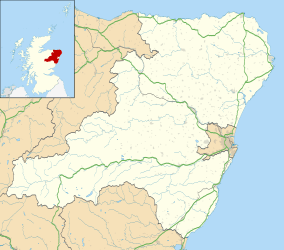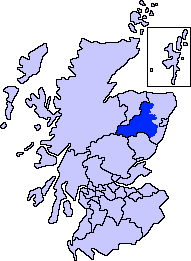Banchory
Banchory (/ˈbæŋxəri/, Scots: Banchry,[2] Scottish Gaelic: Beannchar) is a burgh or town in Aberdeenshire, Scotland. It is about 18 miles (29 km) west of Aberdeen, near where the Feugh River meets the River Dee.
Banchory
| |
|---|---|
 Banchory High Street | |
 Banchory Location within Aberdeenshire | |
| Population | 7,520 [1] (Aberdeenshire Council) |
| OS grid reference | NO698958 |
| • Edinburgh | 81 mi (130 km) |
| • London | 395 mi (636 km) |
| Council area | |
| Lieutenancy area | |
| Country | Scotland |
| Sovereign state | United Kingdom |
| Post town | BANCHORY |
| Postcode district | AB31 |
| Dialling code | 01330 |
| Police | Scotland |
| Fire | Scottish |
| Ambulance | Scottish |
| UK Parliament | |
| Scottish Parliament | |
Overview
The name is thought to be derived from an early Christian settlement founded by St Ternan. It is claimed that Ternan was a follower of St Ninian. Tradition has it that he established his settlement on the banks of the River Dee on what was later to become the kirkyard of the medieval parish of Banchory-Ternan.[3] The village and parish retained the name until the 1970s. The original Gaelic form is almost identical to that of Bangor, of similar meaning, and also the site of a monastery, in Northern Ireland. Relics associated with St. Ternan were preserved by hereditary keepers at Banchory until the Scottish Reformation. Two early Christian cross-slabs survive in or near the old churchyard on the site of the early church. One is built into a corner of the 'mort house' in the churchyard, and shows two crosses incised in a worn pink granite slab. The other is a ringed cross in relief built into the wall facing the main road outside the churchyard.
Banchory is the largest town in the area and has a High Street. There are a number of hotels and restaurants including the Stag Hotel, Scott Skinners Bar and Restaurant, the Burnett Arms, and the Douglas Arms. The shops include newsagents, sports shops and chemists. Since the 1970s, the town has grown steadily. Since 2001 there has been rapid expansion. A large forested area 'the Hill of Banchory', owned by the Burnett family (owners of Crathes Castle), to the north east of the town has been replaced by a large housing estate and an influx of new residents. The Hill of Banchory primary school was opened in 2006 to cater for the increased population.
The Kinneskie Road drill hall was completed in around 1908.[4]
Land use
As a small rural town, surrounded by forestry and agricultural land, Banchory has seen considerable expansion in recent years. Development pressure continues to be strong and the town's population now exceeds 8,001. As Banchory expands, more demands are placed on local infrastructure such as doctors, dentists, sports facilities, swimming pool and schools. In recent years, the Bellfield Doctor's Surgery, the Fountain Dental Surgery, the Morrisons Supermarket and Banchory Academy have all undergone extended and upgraded facilities. In 2010, Tesco built an eco-store to the east of the town, it is hoped this will encourage further residential development to this end of the town.
Banchory Academy is a state (public) secondary school, with a school roll of over 950. Despite strong opposition from the local community, a retirement home 'Dalvenie Home' was built on land next to the Academy in the 1990s. The planning process was taken to the Scottish Office where local opposition was over-ruled. The retirement home opened in 2001 and has restricted expansion of the Academy and the adjacent sports centre.
The pressure for development and the value of land in Banchory means that the Primary and Secondary School Campus area is being considered for sale to housing developers, with sites for a new Academy and a new Primary being investigated.
Tourism and culture
Banchory is known as the Gateway to Royal Deeside.[5] It is surrounded by lovely rural countryside and attractive hills. For the visitor, the town has much to offer with two famous castles nearby, Crathes and Drum – both run by the National Trust for Scotland. The Bridge of Feugh offers the chance to see salmon leaping and there are numerous fine golf courses nearby.[6]
The small town museum recognises that this is the birthplace of James Scott Skinner and supports many local traditional musicians and singers and also has a fine selection of local archaeology. Local landmarks include Scolty hill; a hill topped by a tower monument, a memorial to General Burnett who fought alongside Wellington.

The immediate area is rich in Pictish archaeological sites with numerous stone circles being present in woodlands surrounding the town. Localised excavations of such sites have yielded numerous artefacts including jewellery made from polished local granite and early rudimentary forms of bottle openers.
Local sports teams include Banchory St Ternan football club, Banchory Community Football Club (Football), Banchory Amateurs(Football), Deeside RFC (Rugby), the Banchory Beavers swimming team and the Banchory Stags Basketball Club. Banchory has three summer league football teams (Banchory thistle, Banchory youngstars and Banchory stoats) which compete in the mid-Deeside summer league. There is also the Lirvob-dna-Eip (Pie-and-Bovril) bowls team.
Despite an inadequate and shallow 20 metre swimming pool, which cannot be used for swimming competitions, Banchory Beavers swim team achieves national success. Aberdeenshire Council have agreed to include in their Capital Plan the building of a Sports Facility at Hill of Banchory. To ensure the project is providing the facilities that the community requires a substantial financial contribution is necessary to be raised from the Community which will guarantee a six lane swimming pool, a learner pool, a four court sports hall, be built.[7]
Banchory River Festival is held every June and features a weekend of varied activities and attractions for all ages. The main event is held on the Saturday in the Bellfield Park, Banchory with dozens of stalls each with their own unique feature.[8]
The Banchory show is held every July and attracts a good sized crowd to King George V Park. There is an Agricultural Show, Dog Show, Craft Fair, Highland Dancing Competition and the Scolty Hill Race, as well as traditional fairground stalls and games.[9]
The Royal Deeside Railway[10] originating at Milton of Crathes will shortly run to Banchory; this line is part of the original line to Ballater.
Scotland's only Rum distillery, Dark Matter Distillers, is located on the outskirts of Banchory.[11]
Notable people
- Sir John Macqueen Cowan, botanist[12]
- James Scott Skinner fiddler and composer
- Caroline Phillips Scottish suffragette and journalist, who owned Banchory Station Hotel 1912 to 1940s
- Pete Cashmore founder of technology blog Mashable
- Ben Kilner Snowboarder, Winter Olympian
- Norman Douglas Scottish novelist and travel writer
- Andrew Considine Footballer for Aberdeen FC
- Victor Hugo Actor
See also
- Banchory Ternan East Parish Church
- Glen O'Dee Hospital
References
- "Comparative Population Profile: Banchory Locality" (PDF). Aberdeenshire Council. 2012. Archived from the original (PDF) on 10 August 2016. Retrieved 11 September 2016.
- The Online Scots Dictionary
- David Jameson, W. Stewart Wilson (1999). Old Banchory. Catrine, Ayrshire: Stenlake Publishing. p. 3. ISBN 9781840330878.
- "Banchory, 17 Kinneskie Road, Drill Hall". Canmore. Retrieved 26 June 2017. (The 1:2500, 2nd edition, Ordnance Survey Plan, published in 1904-1905, does not show the drill hall)
- "Banchory". Discover Royal Deeside. Archived from the original on 20 October 2013.
- "Banchory Royal Deeside". Archived from the original on 3 May 2007. Retrieved 7 May 2007.
- "By Banchory - For Banchory". Banchory Sports Village. Retrieved 15 July 2017.
- "Archived copy". Archived from the original on 29 November 2014. Retrieved 22 November 2014.CS1 maint: archived copy as title (link)
- "Banchory Show". Archived from the original on 28 September 2007. Retrieved 7 May 2007.
- "Royal Deeside Railway". Archived from the original on 25 May 2011. Retrieved 8 February 2011.
- "Dark Matter Spiced Rum - Scottish Rum Distillery".
- "Former Fellows of The Royal Society of Edinburgh" (PDF). Retrieved 15 July 2017.
External links
| Wikimedia Commons has media related to Banchory. |
| Wikivoyage has a travel guide for Banchory. |

